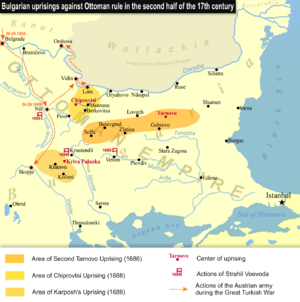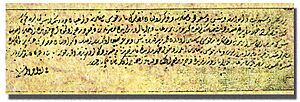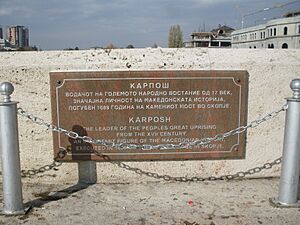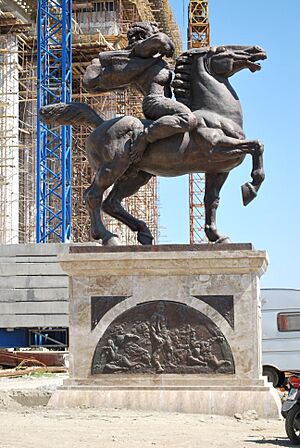Karposh's rebellion facts for kids
Karposh’s Rebellion was a big uprising by Christians against the Ottoman Empire in October 1689. It happened in the central Balkans region.
The leader of this rebellion was a man named Karposh. He was born in a part of the Ottoman Empire called the Sanjak of Üsküp, which is near today's Kumanovo in North Macedonia. When he was young, he went to Wallachia (modern-day Romania) and worked as a miner. Later, he became a famous hajduk, which was like a rebel or freedom fighter. He started organizing groups to fight against the Ottomans when the army of the Holy Roman Empire moved into the Balkans.
Contents
Why the Uprising Started
In 1683, several European powers formed a group called the Holy League. This group included Austria, Poland, Venice, and later Russia. Their goal was to fight against the Ottoman Empire.
The Ottomans suffered a big defeat at the Battle of Vienna in 1683. This forced them to retreat quickly from Central Europe. This defeat caused a lot of problems and confusion within the Ottoman Empire, especially in areas like Üsküp (Skopje) and Niş (Niš). This chaotic situation set the stage for Karposh's rebellion.
On October 25, 1689, the Austrian army, led by General Piccolomini, reached the area around Skopje. The local people were very happy to see them. However, Piccolomini decided to withdraw his forces. On October 26, he set fire to the city of Skopje. The city burned for two whole days, destroying most of it. Some say Piccolomini burned Skopje because his army couldn't hold the city so far from their main base. Others say it was to stop the spread of a disease.
The Rebellion Begins
In October 1689, the uprising officially began in the region between Kyustendil, Pirot, and Skopje. According to some historians, Karposh was first a leader of Christian helper forces for the Ottomans. He was supposed to fight against other rebels.
However, Karposh changed sides. He attacked and captured Eğri Palanka (Kriva Palanka), which was an Ottoman stronghold. He made this town the main base for his rebellion. After securing Kriva Palanka, the rebels built another strong fort near Kumanova (Kumanovo).
It's not fully clear if the Austrians helped Karposh's rebels directly. According to stories from that time, Karposh became known as the "King of Kumanovo." It's said that Emperor Leopold I of the Holy Roman Empire even sent him a special hat as a gift, showing his recognition.
The Rebellion is Stopped
Things did not go well for the rebels. The Ottoman authorities decided they needed to crush the rebellion and push the Austrian army out of their lands. To do this, they asked for help from the Crimean Khan Selim I Giray.
A meeting was held in Sofia on November 14, 1689. They decided to attack the rebels through Kyustendil. First, they had to secure Kriva Palanka. When the rebels found out they were about to be attacked, they set fire to Kriva Palanka themselves. Then, they gathered all their forces in the new fortress at Kumanovo.
They barely had time to prepare when the Ottoman and Tatar armies arrived. The rebels were quickly overwhelmed because the Ottoman forces were much larger. Many rebels, including Karposh, were captured right away. This event became known as the Second Battle of Kumanovo.
After the battle, all the rebels who resisted were killed. Karposh and the other prisoners were taken to Skopje. It is believed that Karposh was executed on the historic Stone Bridge in Skopje.
What Happened Next
For the rebels who survived the battles, there was no safety from the Ottomans unless they left the Balkans. Many of them fled north, crossing the Sava and Danube Rivers to escape.
Karposh's Legacy
Today, Karposh is remembered in several ways:
- Karpoš Municipality, one of the 10 parts of the city of Skopje, the capital of North Macedonia, is named after him.
- Hristijan Todorovski Karpoš, a Yugoslav Communist and Macedonian Partisan during World War II, chose his nickname after the original Karposh.
- Karposh Square in Skopje, located near the Stone Bridge where he was executed, is also named after him. There is a monument and a plaque there to remember the execution site.
- Karposh Point on Snow Island in Antarctica is also named after Karposh.





